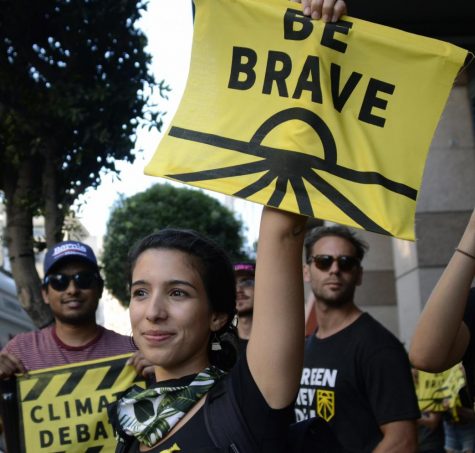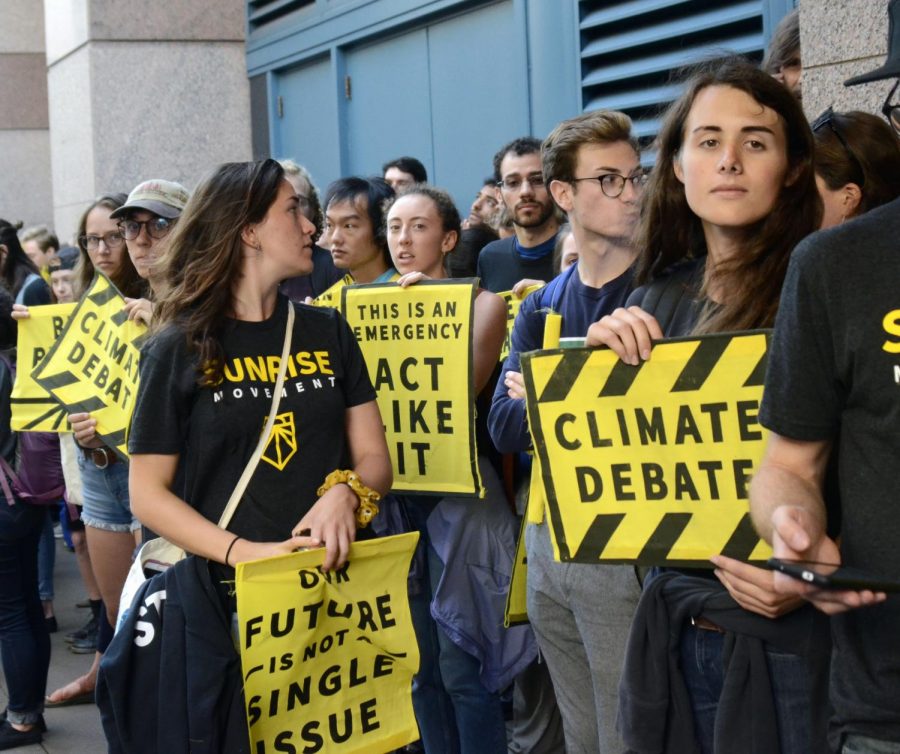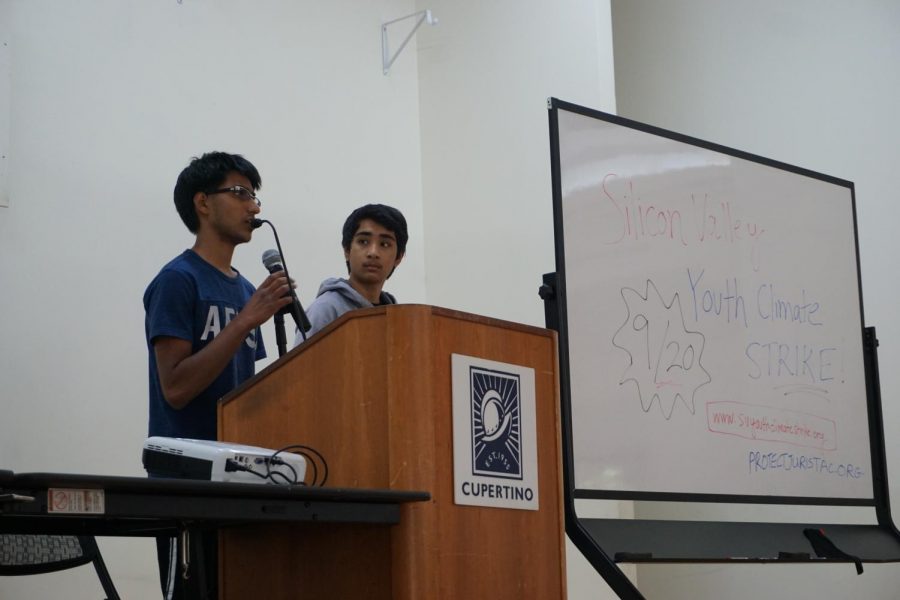Global Reset: “The existential crisis of our time”
Bay Area youth take action against worsening environmental conditions across the world
The logistics team brainstorms how to get students to Diridon, the starting place of the Sept. 20 climate strike.
August 30, 2019
Youth demand climate action
The sidewalk outside the Hilton San Francisco Union Square hotel was flooded with yellow. Last Friday, over 250 young people protested outside of the hotel, where the Democratic National Committee’s summer meeting was being held. They carried yellow posters with words like “Be Brave” and “Climate Debate,” singing protest songs like “Which Side Are You On?” in unison.
The youth-led political group, the Sunrise Movement, organized demonstrations throughout the DNC event in committee meetings, hallways and outside the hotel. The protesters called for the DNC to allow for a Democratic presidential debate that specifically focuses on climate-related issues.
“The biggest obstacle [to a climate debate] is the whole way that the debate system works right now. It’s not listening to the people in the same way that it should be,” Carmen Bouquin, an organizer in the movement, said in a Winged Post interview.

A protester waves a banner calling for immediate action on climate change.
Founded in 2013, the Sunrise Movement formed to put political pressure on elected officials to take action on climate change. Since then, the group has organized demonstrations on the national and local level, including a Nov. 13, 2018 sit-in in Speaker Nancy Pelosi’s office. Among other things, the group advocates for a Green New Deal, a bill that would address climate change and economic inequality. The movement’s Bay Area branch was launched July 2017.
Frontrunners in the Democratic presidential race Joe Biden, Bernie Sanders, Elizabeth Warren and Kamala Harris have all spoken out in support of a climate debate. Tom Steyer, who entered the race on July 9, supports immediate executive action on climate change.
“I said on day one I would declare a state of emergency on climate because in fact if we don’t start on day one, we will miss the window to keep control of the situation,” Steyer said in an interview with Winged Post at the DNC meeting.
In a June statement, DNC chairman Tom Perez warned that allowing a climate debate would open the door to requests for other single-issue debates, which the DNC could not all honor. In a 17-8 vote and a 222-137 vote last Thursday and Saturday respectively, DNC members voted down resolutions that would have allowed for a climate debate.
While not a debate, CNN will host individual town halls on climate change for 10 of the candidates on Sept. 4.
Silicon Valley youth hold summit to organize upcoming climate strike
The second annual Silicon Valley Youth Climate Summit was held at Quinlan Center in Cupertino on Aug. 18. Climate activists from all over the Bay Area gathered to plan the upcoming Global Youth Climate Strike on Sept. 20.
Organized in accordance with Bay Area for Clean Environment by Youth Climate Coalition Leaders Peri Plantenberg (10) of Homestead high school, May Jiang (11) of Los Altos high school, Helen Deng (11) of Archbishop Mitty and Navya Pariti (12) of St. Francis high school, the Silicon Valley strike will be held in solidarity with climate activist Greta Thunberg and the #FridaysForFuture protesters, who started the international school strikes.
“The point of the strike is we want to let the people in power know that this is an issue that we care about and that we demand that they take action because it is our future, and we are going to be the ones who will be affected the most,” Peri, who also helped organize the San Jose Climate March on May 3, said.
The summit comprised of three groups: logistics, outreach, and marketing, all of which worked together to plan the strike, which will begin at Diridon station and end at San Jose City Hall.
“It’s super important for people to understand the urgency of climate change because we’ve already seen the effects and it’s already happening,” May, who oversees outreach, said. “If we don’t act soon then there will be no future for us.
The meeting also included speakers from San Jose State University, the Amah Mutsun Tribal Band, and several other students presenting on initiatives to preserve the environment, including boycotting the building of a quarry in sacred lands and reducing emissions from Valley Transportation Authority vehicles.
“A huge thing as we’re making this transition is that we do it in a way that is socially and environmentally just,” Dashiell Leeds, a member of the Loma Prieta chapter of the environmental group Sierra Club, said. “So let’s respect nature and let’s respect indigenous people.”
July heat breaks global record
With widespread heat waves over the summer, heat records have been broken in cities from San Francisco to Paris. According to the National Oceanic and Atmospheric Administration, July was the hottest month on record with temperatures exceeding the 20th century average by 1.71 degrees Fahrenheit.
The Bay Area felt the effects of this warming. Heat waves led San Francisco to experience its highest recorded temperature on June 9, hitting 100 degrees Fahrenheit. The heat resulted in widespread power outages, delays in Bay Area Rapid Transit trains, increased fire risk and poor air quality.
Dr. Inez Fung, University of California at Berkeley professor of atmospheric science, and Dr. Daniel Swain, University of California at Los Angeles climate scientist, both expressed that they were alarmed but unsurprised by this year’s record heat. Though the rise in temperature is consistent with what scientists predicted over 30 years ago, climate change seems to be happening at a faster-than-expected rate. In addition to an increased rate of wildfires, California’s food and water supplies may be particularly affected.
“Right now for California we are counting on our natural reservoir, the snowpack. When it is warmer, there may not be a snowpack, and we have nothing to replace it,” Fung said.
According to Swain, urban areas in California will be particularly susceptible to rising temperatures. Human activities in cities can create heat islands that are significantly hotter than surrounding areas. Besides taking steps to reduce global warming, cities can adapt by developing more green spaces.
“While we can’t avoid all of the global warming that’s currently projected, we can avoid a lot of it, maybe even a majority of it, depending on the choices we make in the near future,” Swain said.
Rising temperatures have already affected the daily lives of people across the U.S. As in the Bay Area, the East Coast from Maine to Virginia experienced record high temperatures. In July, a heat dome, where high-pressure air in the atmosphere traps ocean heat, formed over the Midwest, with temperatures as high as 110 degrees Fahrenheit, according to the National Weather Service. In Phoenix, Arizona, a postal service worker cooked a steak to 142 degrees by leaving it on the dashboard of his truck for two and a half hours to demonstrate the high levels of heat. To protect residents, cities nationwide provided access to pools, spray fountains and cooling centers.
Jakarta defends against city sinking
On May 1, Jakarta’s President, Joko Widodo, announced a plan to move the capital of Indonesia from Jakarta to 100 miles away from Jakarta. As a result of rising sea levels and excessive groundwater pumping, some parts of Jakarta are sinking at an alarming rate of 10 inches per year, according to BBC. Though the government has taken measures to deal with this challenge, environmental experts forecast that by 2050 about 95% of North Jakarta will be submerged.
With tropical monsoons for eight months of the year, the coastal city has been prone to flooding of increasing frequency and intensity due to climate change. Additionally, overcrowding in the city has led to excessive groundwater pumping, which has contributed to the city sinking. Major floods in 2007 and 2013 led to loss of human lives and economic wreckage.
The government has taken measures to deal with this issue by building sea walls and a network of canals.
Mani Jayaram, a resident of Jakarta since 2007, remarked on the limited effectiveness of these measures. For example, the city government built an elevated road to the airport to prevent airport access from being cut off during heavy rains, but the road may not be able to withstand all cloudbursts.
“Where does the government invest more money? To reduce poverty or reduce floods?” Jayaram said. “We have limited monetary resources and lots of challenges to deal with.”
Jayaram believes moving the capital may not be an easy solution, as Jakarta is the economic hub of the country.
“Changing the capital will not change the situation,” he said. “People will still be in places where there are opportunities. We only have to find alternate solutions to mitigate the problem.”
Coastal cities across the world, such as Venice, Houston, Miami and Bangkok, face a situation similar to Jakarta’s. Rising sea levels caused by rising ocean temperatures can be mitigated by lowering carbon emissions, which requires global cooperation.




![LALC Vice President of External Affairs Raeanne Li (11) explains the International Phonetic Alphabet to attendees. "We decided to have more fun topics this year instead of just talking about the same things every year so our older members can also [enjoy],” Raeanne said.](https://harkeraquila.com/wp-content/uploads/2025/10/DSC_4627-1200x795.jpg)


















![“[Building nerf blasters] became this outlet of creativity for me that hasn't been matched by anything else. The process [of] making a build complete to your desire is such a painstakingly difficult process, but I've had to learn from [the skills needed from] soldering to proper painting. There's so many different options for everything, if you think about it, it exists. The best part is [that] if it doesn't exist, you can build it yourself," Ishaan Parate said.](https://harkeraquila.com/wp-content/uploads/2022/08/DSC_8149-900x604.jpg)




![“When I came into high school, I was ready to be a follower. But DECA was a game changer for me. It helped me overcome my fear of public speaking, and it's played such a major role in who I've become today. To be able to successfully lead a chapter of 150 students, an officer team and be one of the upperclassmen I once really admired is something I'm [really] proud of,” Anvitha Tummala ('21) said.](https://harkeraquila.com/wp-content/uploads/2021/07/Screen-Shot-2021-07-25-at-9.50.05-AM-900x594.png)







![“I think getting up in the morning and having a sense of purpose [is exciting]. I think without a certain amount of drive, life is kind of obsolete and mundane, and I think having that every single day is what makes each day unique and kind of makes life exciting,” Neymika Jain (12) said.](https://harkeraquila.com/wp-content/uploads/2017/06/Screen-Shot-2017-06-03-at-4.54.16-PM.png)








![“My slogan is ‘slow feet, don’t eat, and I’m hungry.’ You need to run fast to get where you are–you aren't going to get those championships if you aren't fast,” Angel Cervantes (12) said. “I want to do well in school on my tests and in track and win championships for my team. I live by that, [and] I can do that anywhere: in the classroom or on the field.”](https://harkeraquila.com/wp-content/uploads/2018/06/DSC5146-900x601.jpg)
![“[Volleyball has] taught me how to fall correctly, and another thing it taught is that you don’t have to be the best at something to be good at it. If you just hit the ball in a smart way, then it still scores points and you’re good at it. You could be a background player and still make a much bigger impact on the team than you would think,” Anya Gert (’20) said.](https://harkeraquila.com/wp-content/uploads/2020/06/AnnaGert_JinTuan_HoHPhotoEdited-600x900.jpeg)

![“I'm not nearly there yet, but [my confidence has] definitely been getting better since I was pretty shy and timid coming into Harker my freshman year. I know that there's a lot of people that are really confident in what they do, and I really admire them. Everyone's so driven and that has really pushed me to kind of try to find my own place in high school and be more confident,” Alyssa Huang (’20) said.](https://harkeraquila.com/wp-content/uploads/2020/06/AlyssaHuang_EmilyChen_HoHPhoto-900x749.jpeg)















